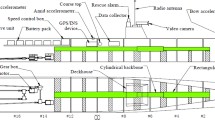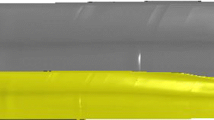Abstract
Conducting model experiments is an effective and reliable way in the investigation of ship hydrodynamic and hydroelastic behaviors. A survey of model testing techniques for ship hydroelasticity and its prospect are presented in this paper. The research highlights with respect to ship hydroelasticity and key points in model testing are summarized at first. Then testing techniques including laboratory tank test and full-scale sea trial are reviewed, and both their advantages and disadvantages are analyzed comprehensively. Based on the conventional testing approaches, a state-of-the-art testing approach which includes performing tests using large-scale model at sea is proposed. Furthermore, recommendations towards the further development of ship hydroelasticity tests are forecasted and discussed.
Similar content being viewed by others
References
CUIW C, YANG J M, WU Y S, et al. Theory of hydroelasticity and its application to very large floating structures [M]. Shanghai: Shanghai Jiao Tong University Press, 2007: 1–4.
HELLER S R, ABRAMSON H N. Hydroelasticity: A new naval science [J]. Journal of American Society of Naval Engineers, 1959, 71(2): 205–209.
TIAN C, WU Y S. Review of research on the hydroelasticity of ship [J]. Shipbuilding of China, 2008, 49(4): 1–11 (in Chinese).
TEMAREL P, BAI W, BRUNS A, et al. Prediction of wave-induced loads on ships: Progress and challenges [J]. Ocean Engineering, 2016, 119: 274–308.
HIRDARIS S E, BAI W, DESSI D, et al. Loads for use in the design of ships and offshore structures [J]. Ocean Engineering, 2014, 78: 131–174.
TEMAREL P, CHEN X B, ENGLE A, et al. ISSC report: Volume 1, Committee I.2 loads [R]. Southampton, UK: 16th International Ship and Offshore Structures Congress (ISSC), 2006: 87–173.
LEE Y W, WHITE N, WANG Z H, et al. Comparison of springing and whipping responses of model tests with predicted nonlinear hydroelastic analyses [C]// Proceedings of the 21th International Offshore and Polar Engineering Conference (ISOPE). Hawaii: ISOPE, 2011: 453–460.
OGAWA Y, TAKAGI K. An assessment of the effect of hull girder vibration on the statistical characteristics of wave loads [J]. International Journal of Naval Architecture and Ocean Engineering, 2011, 3(1): 80–85.
JIAO J L, REN H L. Characteristics of bow-flare slamming and hydroelastic vibrations of a vessel in severe irregular waves investigated by segmented model experiments [J]. Journal of Vibroengineering, 2016, 18(4): 2475–2494.
KIM J H, KIM Y H, YUCK R H, et al. Comparison of slamming and whipping loads by fully coupled hydroelastic analysis and experimental measurement [J]. Journal of Fluids and Structures, 2015, 52: 145–165.
DRUMMEN I, HOLTMANN M. Benchmark study of slamming and whipping [J]. Ocean Engineering, 2014, 86: 3–10.
DESSI D, CILAPPI E. Slamming clustering on fast ships: From impact dynamics to global response analysis [J]. Ocean Engineering, 2013, 62: 110–122.
CHIU F C, TIAO W C, GUO J. Experimental study on the nonlinear pressure acting on a high-speed vessel in irregular waves [J]. Journal of Marine Science Technology, 2009, 14(2): 228–239.
HONG S Y, KIM K H, KIM B W, et al. Experimental study on the bow-flare slamming of a 10 000 TEU containership [C]// Proceedings of the 24th International Offshore and Polar Engineering Conference (ISOPE). Busan: ISOPE, 2014: 816–823.
CHEN Z Y, REN H L, SUN F S. Model experiment of time distribution of flare slamming [J]. Journal of Shanghai Jiao Tong University, 2013, 47(6): 904–908 (in Chinese).
LUO H B, XU H, YU J X, et al. Review of the state of the art of dynamic responses induced by slamming loads on ship structures [J]. Journal of Ship Mechanics, 2010, 14(4): 439–450 (in Chinese).
STENIUS I, ROSEN A, BATTLEY M, et al. Experimental hydroelastic characterization of slamming loaded marine panels [J]. Ocean Engineering, 2013, 74: 1–15.
ZHU R C, LIN Z W, MIAO G P. Numerical simulation for green water occurrence [J]. Journal of Hydrodynamics. 2006, 18(3): 498–504.
GRECO M, BOUSCASSE B, LUGNI C. 3D seakeeping analysis with water on deck and slamming. Part 2. Experiments and physical investigation [J]. Journal of Fluids and Structures, 2012, 33(5): 148–179.
JI Y M, SHIN Y S, PARK J S, et al. Experiments on non-resonant sloshing in a rectangular tank with large amplitude lateral oscillation [J]. Ocean Engineering, 2012, 50: 10–22.
WANG X L, GU X K, HU J J, et al. Investigation of sloshing an its effects on global responses of a large LNG carrier by experimental method [J]. Journal of Ship Mechanics, 2012, 16(12): 1394–1401 (in Chinese).
LEE K H, CHO S, KIM K T, et al. Hydroelastic analysis of floating structures with liquid tanks and comparison with experimental tests [J]. Applied Ocean Research, 2015, 52: 167–187.
DOMNISORU L, DOMNISORU D. Experimental analysis of springing and whipping phenomena [J]. International Shipbuilding Progress, 2000, 47(450): 129–140.
LIN J R. On the springing vibration of large ships [J]. Ship Engineering, 1995, 2: 4–9 (in Chinese).
KIM S P, YU H C, HONG S Y. Segmented model testing and numerical analysis of wave-induced extreme and springing loads on large container carriers [C]// Proceedings of the 20th International Offshore and Polar Engineering Conference (ISOPE). Beijing: ISOPE, 2010: 385–392.
HONG S Y, KIM B W. Experimental investigations of higher-order springing and whipping-WILS project [J]. International Journal of Naval Architecture and Ocean Engineering. 2014, 6(4): 1160–1181.
ADENYA C A, REN H L, LI H, et al. Estimation of springing response for 550 000 DWT ore carrier [J]. Journal of Marine Science and Application, 2016, 15(3): 260–268.
LUO H B, QIU Q, WAN Z Q, et al. Experimental investigation of the stern slamming and whipping in regular and irregular wave [J]. Journal of Ship Mechanics, 2006, 10(3): 150–162.
HONG S Y, KIM K H, KIM BW, et al. Characteristics of bow-flare slamming loads on an ultra-large containership in irregular waves [C]// Proceedings of the 25th International Offshore and Polar Engineering Conference (ISOPE). Hawaii: ISOPE, 2015: 75–81.
JIAO J L, SUN S Z, REN H L. Predictions of wave induced ship motions and loads by large-scale model measurement at sea and numerical analysis [J]. Brodogradnja, 2016, 67(2): 81–100.
LEE S J, YU H C, KIM S P, et al. Analysis of fullscale hull girder loads of a container carrier and its simulation using a nonlinear seakeeping program [C]// 29th International Conference on Ocean, Offshore and Arctic Engineering (OMAE). Shanghai: OMAE, 2010. 1–8.
The Seakeeping Committee. Final report and recommendations to the 27th ITTC [R]. Copenhagen: ITTC, 2014.
AKITA Y, OCHI K. Investigations on the strength of ships going in waves by model experiments [J]. Journal of Zosen Kiokai, 1955, 96: 31–38 (in Japanese).
WATANABE I, UENO M, SAWADA H. Effects of bow flare shape to the wave loads of a container ship [J]. Journal of the Society of Naval Architects of Japan, 1989, 166: 259–266.
LIN J R, ZHENG S L, SUN Y, et al. Experimental techniques of the continued elastic model [J]. Shipbuilding of China, 1992, 2: 63–71 (in Chinese).
IIJIMA K, HERMUNDSTAD O A, ZHU B S, et al. Symmetric and antisymmetric vibrations of a hydroelastically scaled model [C]// Hydroelasticity in Marine Technology (Proceedings of the 5th International Conference). Southampton, UK: University of Southampton, 2009: 173–182.
ROUSSET J M, FERRANT P, ALESSANDRINI B. Experiments on a segmented ship model in directional irregular waves [C]// Proceedings of the 21th International Workshop on Water Waves and Floating Bodies. Loughborough, UK: IWWWFB, 2006: 1–4.
CHEN Z Y, REN H L, LI H, et al. The wave load experimental investigation of a segmented model of a very large ship based on variable cross-section beams [J]. Journal of Harbin Engineering University, 2012, 33(3): 263–268 (in Chinese).
JIAO J L, REN H L, ADENYA C A. Experimental and numerical analysis of hull girder vibrations and bow impact of a large ship sailing in waves [J]. Shock and Vibration, 2015, 706163: 1–10.
JIAO J L, REN H L, YANG H, et al. Design of channelsection backbone of segmented model for wave loads experiment [J]. Journal of Vibration and Shock, 2015, 34(14): 11–15 (in Chinese).
MARON A, KAPSENBERG G. Design of a ship model for hydro-elastic experiments in waves [J]. International Journal of Naval Architecture and Ocean Engineering. 2014, 6(4): 1130–1147.
ZHU S J, WU M K, MOAN T. Experimental investigation of hull girder vibrations of a flexible backbone model in bending and torsion [J]. Applied Ocean Research, 2011, 33(4): 252–274.
REN H L, CHEN Z Y. Effect of self propulsion and towing test on ship load response [J]. Journal of Huazhong University of Science and Technology, 2012, 40(11): 84–88 (in Chinese).
JIA L H, REN H L, SUN S Z, et al. Research on ship structural stress monitoring points selection method [J]. Journal of Ship Mechanics, 2013, 17(4): 389–397 (in Chinese).
REN H L, JIA L H, ZHEN C B, et al. Design of ship structural stress monitoring and strength assessment system [J]. Journal of Wuhan University of Technology, 2013, 35(8): 60–65 (in Chinese).
MIYAKE R, MATSUMOTO T, YAMAMOTO N, et al. On the estimation of hydroelastic response acting on a ultra-large container ship [C]// Proceedings of the 20th International Offshore and Polar Engineering Conference (ISOPE). Beijing: ISOPE, 2010: 849–856.
ANDERSEN I M V, JENSEN J J. Measurements in a container ship of wave-induced hull girder stresses in excess of design values [J]. Marine Structures, 2014, 37: 54–85.
JACOBI G, THOMAS G, DAVIS M R, et al. An insight into the slamming behaviour of large high-speed catamarans through full-scale measurements [J]. Journal of Marine Science and Technology, 2014, 19(1): 15–32.
THOMAS G, WINKLER S, DAVIS M, et al. Slam events of high-speed catamarans in irregular waves [J]. Journal of Marine Science and Technology, 2011, 16(1): 8–21.
LAVROFF J, DAVIS M R, HOLLOWAY D S, et al. Wave slamming loads on wave-piercer catamarans operating at high-speed determined by hydro-elastic segmented model experiments [J]. Marine Structures, 2013, 33(5): 120–142.
The Seakeeping Committee. Final report and recommendations to the 26th ITTC [R]. Rio de Janeiro: ITTC, 2011.
GRIGOROPOULOS G J, KATSAOUNIS G M. Measuring procedures for seakeeping tests of large-scaled ship models at sea [C]// 13th IMEKO TC4 Symposium on Measurements for Research and Industrial Applications. [s.l.]: IMEKO, 2004: 135–139.
USS. Zumwalt class destroyer DDG-1000 [EB/OL]. (2010-04-30) http://military.china.com/zh_cn/05/11078235/20100430/15917640 4.html
CORADDU A, DUBBIOSO G, MAURO S, et al. Analysis of twin screw ships’ asymmetric propeller behaviour by means of free running model tests [J]. Ocean Engineering, 2013, 68: 47–64.
FOSSATI F, BAYATI I, ORLANDINI F, et al. A novel full scale laboratory for yacht engineering research [J]. Ocean Engineering, 2015. 104: 219–237.
SUN S Z, LI J D, ZHAO X D, et al. Remote control and telemetry system for large-scale model test at sea [J]. Journal of Marine Science and Application, 2010, 9(3): 280–285.
JIAO J L. Experimental investigation of motion and load characteristics of a large-scale model ship in actual sea waves [D]. Harbin, China: Harbin Engineering University, 2016.
SUN S Z, REN H L, ZHAO X D, et al. Experimental study of two large-scale models’ seakeeping performance in coastal waves [J]. Brodogradnja, 2015, 66(2): 47–60.
JIAO J L, REN H L, SUN S Z, et al. A state-of-the-art large scale model testing technique for ship hydrodynamics at sea [J]. Ocean Engineering, 2016, 123: 174–190.
JIAO J L, REN H L, SUN S Z, et al. Investigation of a ship’s hydroelasticity and seakeeping performance by means of large-scale segmented self-propelling model sea trials [J]. Journal of Zhejiang University (Science A), 2016, 17(6): 468–484.
Author information
Authors and Affiliations
Corresponding author
Additional information
Foundation item: the National Natural Science Foundations of China (Nos. 51679049 and 51079034)
Rights and permissions
About this article
Cite this article
Jiao, J., Ren, H. & Chen, C. Model testing for ship hydroelasticity: A review and future trends. J. Shanghai Jiaotong Univ. (Sci.) 22, 641–650 (2017). https://doi.org/10.1007/s12204-017-1886-5
Received:
Published:
Issue Date:
DOI: https://doi.org/10.1007/s12204-017-1886-5




